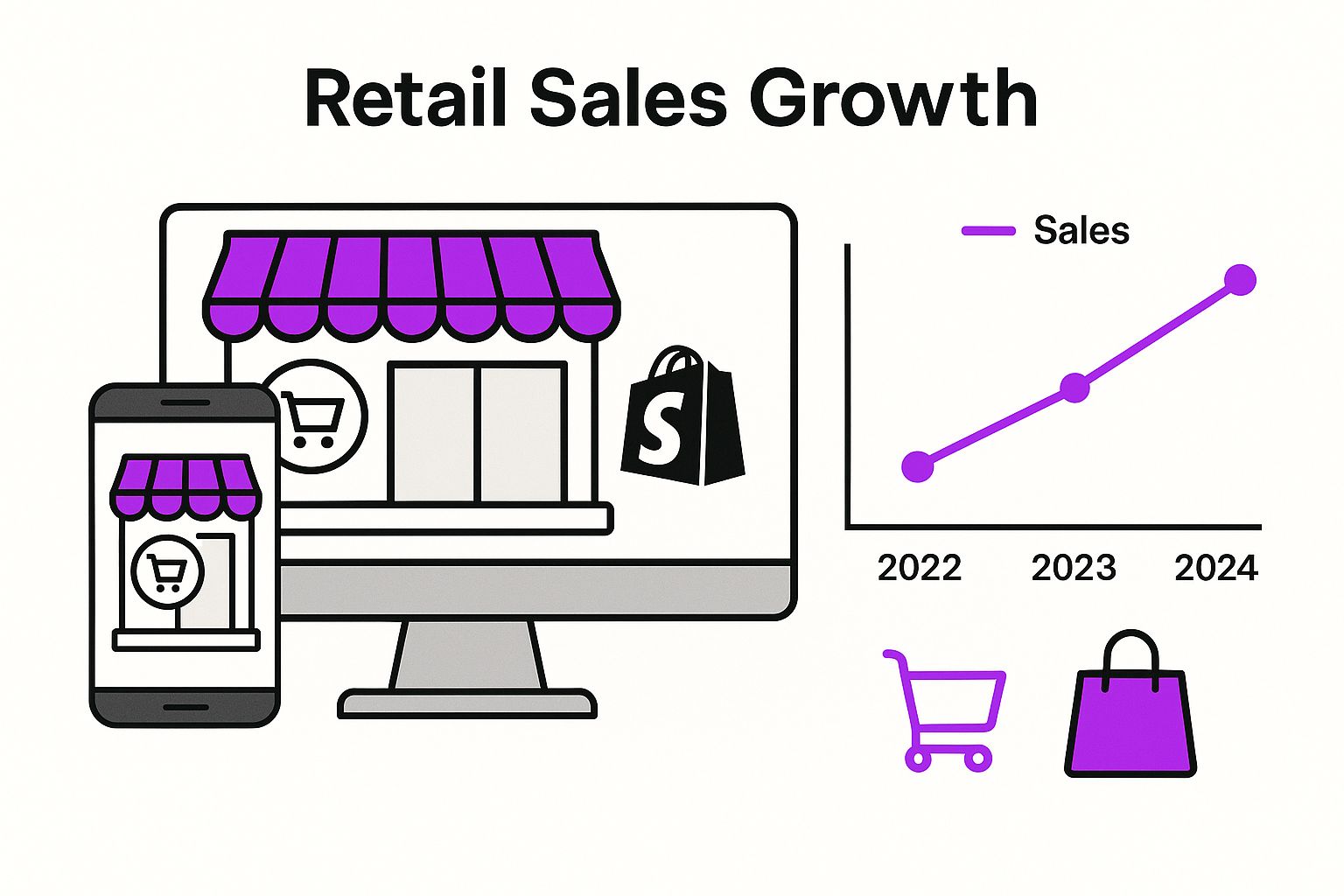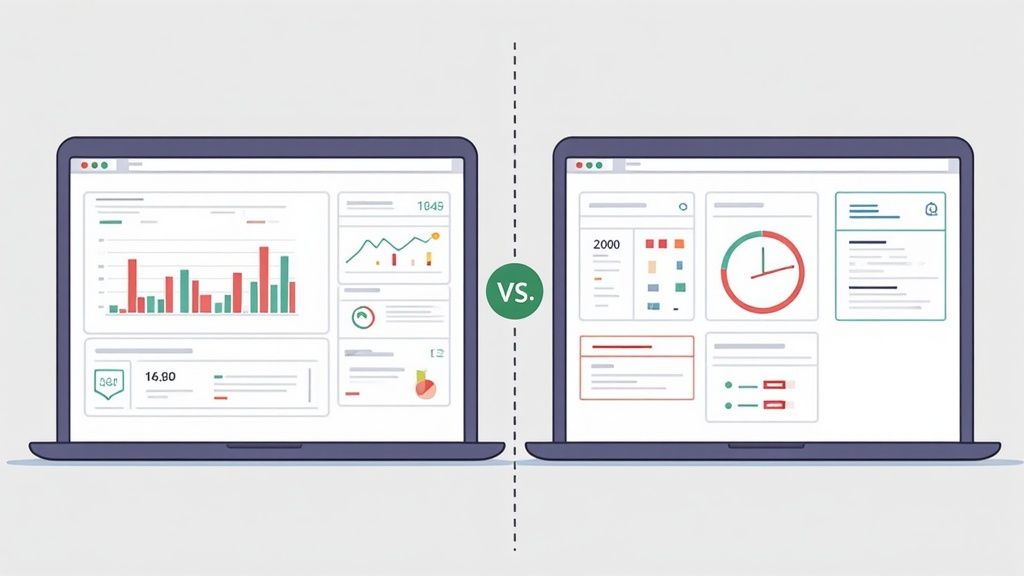
Beyond The Feature Lists: What Actually Matters In Platform Selection
Choosing between Shopify and Magento isn't about ticking boxes on a feature comparison sheet. It's about finding the platform that best fits the daily grind of your business operations. The hidden friction points, the unexpected expenses, and the overall operational impact are what truly shape your experience. These are the details marketing materials often gloss over.
Take order fulfillment, for example. Both platforms integrate with various fulfillment services, but the actual setup and management experience can be vastly different. Shopify’s simplified approach works wonders for businesses with straightforward fulfillment needs.
But for merchants juggling complex, multi-warehouse logistics, Magento’s flexibility might be a better fit, even if it requires more initial configuration. This illustrates the importance of understanding how your existing workflows will translate to each platform.
The technical expertise within your team also plays a crucial role. Shopify’s managed infrastructure eliminates the headaches of server maintenance and security updates, freeing up smaller teams to concentrate on core business activities.
Magento, however, requires substantial technical resources for upkeep, optimization, and security. Choosing Magento means either investing significantly in an internal tech team or outsourcing these critical functions. If Shopify has piqued your interest, exploring platform-specific guides, like this Shopify Guide, can prove beneficial.
This image portrays the global scope of eCommerce, showcasing the diverse markets businesses using platforms like Shopify and Magento operate within. This interconnectedness emphasizes the need for platforms that can handle internationalization, multi-currency transactions, and a diverse customer base. You might find value in our guide on the pros and cons of Shopify for a deeper dive into these considerations.
Ultimately, selecting the right platform comes down to aligning your business’s specific operational style with the strengths of each option. While 4.6 million businesses flourish on Shopify, many others find Magento's extensive customization options crucial to their success. There is no one-size-fits-all "best" platform—only the best fit for your particular needs and operational realities.
Market Reality Check: Why Usage Patterns Matter More Than Headlines

This infographic showcases a sleek storefront, highlighting how Shopify prioritizes a consistent and attractive shopping experience across devices. This user-friendly approach is a big reason why so many businesses, from small startups to large enterprises, choose Shopify.
While market share statistics often dominate the Shopify vs. Magento conversation, they don't tell the whole story. Knowing that Shopify powers over 4.6 million websites is less important than understanding how those businesses use the platform. The real value lies in the details.
Unveiling the Platform Usage Patterns
Looking at industry-specific usage reveals where each platform excels. Shopify is popular in sectors like Lifestyle, Computers, Electronics & Technology, and Food & Drink, indicating a fit for direct-to-consumer brands and those with fairly straightforward products. Effectively managing customer feedback is key, regardless of platform. Check out resources on the best review management software. Magento, conversely, finds its home in Heavy Industry & Engineering, suggesting it handles complex product configurations and B2B sales models better. Choosing the right platform means aligning it with your business needs.
To illustrate these real-world adoption trends, let's examine the following table:
Platform Adoption Patterns by Industry and Region
This table highlights how specific business contexts favor different platform strengths. Understanding these patterns is key to selecting the right tool for the job.
Looking at the numbers, Shopify powers over 4.6 million websites globally. Magento holds around 8% of the e-commerce market share. This difference is significant, but again, context matters more than raw numbers. Learn more by comparing Magento vs Shopify.
The Geographic Dimension
Where your business operates also influences platform choice. Shopify's strong presence in the US, UK, Canada, and Australia suggests solid infrastructure and support in those regions. Magento's foothold in smaller markets might indicate local expertise or particular regional needs. Consider your target market and the platform’s support ecosystem.

This BuiltWith.com screenshot shows the market share distribution for various eCommerce platforms. Shopify's prominent position reflects its widespread adoption. However, remember to look beyond market share and understand the why behind the numbers.
By analyzing these usage patterns, we gain a much clearer picture of each platform's strengths and weaknesses. This informed perspective helps you make the best decision for your unique business needs and long-term objectives.
The Infrastructure Choice That Shapes Everything Else
Choosing between Shopify and Magento is more than just selecting an eCommerce platform; it's a fundamental decision about your business's technical foundation. This architectural difference has ripple effects across your operations, from daily tasks to long-term growth strategies. Shopify's managed approach simplifies the technical side, but can introduce limitations as your business expands. Magento's self-hosted flexibility, while requiring more technical involvement, grants the control that larger businesses often need.
Operational Impacts of Infrastructure
Shopify, with its user-friendly interface (as seen on their homepage: ), prioritizes simplicity. Its managed infrastructure means Shopify takes care of server upkeep, security updates, and performance tuning. This allows merchants to concentrate on other business aspects, but also creates reliance on Shopify's support.
Imagine a sudden server outage. With Shopify, you're dependent on their support team's responsiveness. With Magento, the responsibility falls squarely on you, demanding readily available technical expertise. This contrast drastically affects your operational agility in a crisis.
Customizations also highlight the platforms' differences. Shopify's themes allow for relatively quick design tweaks, but major functional changes are restricted. Magento, being open-source, permits complete customization, but complex modifications require significant development time and expertise. Your ability to respond to changing market dynamics hinges on this distinction.
Third-party integrations are another key consideration. Shopify's app store simplifies connections with many services, but you're confined to its offerings. Magento’s open architecture lets you integrate with nearly any system. This presents immense flexibility but also necessitates greater technical resources. Your ability to connect to specialized tools or existing business systems will be impacted by this choice.
Let's examine these operational differences more closely:
This table highlights the significant differences in how Shopify and Magento affect your daily operations. Understanding these distinctions will guide you toward the platform best suited for your business needs and technical capabilities.
Hidden Costs and Long-Term Implications
Beyond each platform's initial price tag, hidden costs deserve careful consideration. Shopify’s transaction fees, app subscriptions, and potential theme customization expenses can add up. Magento's hosting costs, developer fees, and ongoing maintenance represent a substantial financial commitment. Accurately assessing the total cost of ownership over several years is essential for realistic budgeting.
Ultimately, choosing between Shopify and Magento involves a strategic trade-off. Shopify offers convenience and speed, best suited for businesses prioritizing rapid setup and ease of use. Magento provides control and flexibility, ideal for larger businesses with in-house technical expertise or the budget to outsource development, who anticipate needing extensive customization and integrations. Comprehending these infrastructure implications will empower you to make an informed decision aligned with your operational reality and future growth trajectory.
Why Business Size Rules Don't Always Apply

This screenshot highlights Magento's (Magento) enterprise focus. The platform's scalability and robust features attract larger businesses. However, business size alone shouldn't dictate your choice between Shopify and Magento.
The idea that small businesses automatically choose Shopify and large businesses choose Magento is an oversimplification. Some startups, anticipating rapid growth, embrace Magento's complexity early on. This upfront investment can prevent migration headaches later. It’s a choice that prioritizes future scalability.
For instance, a tech-savvy startup might choose Magento to build a foundation for complex integrations and custom features, even if they're not needed immediately. This strategic foresight can lead to faster growth down the line. For more on scaling within the Shopify ecosystem, see Shopify vs Shopify Plus.
Conversely, some established enterprises prioritize operational efficiency and choose Shopify’s simplicity, despite its limitations. This allows them to focus on their core business, not platform management. The need for streamlined operations can outweigh the desire for extensive customization.
Furthermore, Shopify and Magento cater to different user demographics. Shopify, with over 62% of its stores in the US, is popular among small to medium-sized businesses for its easy setup and scalability. Magento, being open-source, appeals to larger enterprises needing high customization and complex integrations. It offers full control over the eCommerce platform. For further insights on market share, see this article.
The True Cost of Switching Platforms
Choosing between Shopify and Magento is a long-term commitment, not just an initial setup. Migrating platforms incurs significant costs, both financially and operationally. Downtime, data migration issues, and staff retraining can disrupt your business. These hidden costs make switching a last resort, emphasizing the need for careful initial planning.
Ultimately, the right choice depends on your growth trajectory, technical resources, and operational philosophy. Shopify offers ease of use, while Magento offers control and flexibility. Consider these factors, not just your current size. Thinking about where you want to be in five or ten years is crucial for making a sustainable platform choice and avoiding costly future migrations.
The True Cost Equation: Beyond The Sticker Price

This screenshot from AWS illustrates the complexity behind the scenes of any eCommerce operation. It serves as a visual reminder of the hidden costs tied to performance and scalability that go beyond the platform's price tag.
Choosing between Shopify and Magento involves more than just comparing upfront costs. Shopify's tiered monthly pricing appears straightforward, but there are nuances. Transaction fees can add up, especially for high-volume stores. Don't forget the costs of apps, often essential for enhanced functionality, and premium themes for a polished look.
These hidden costs often surprise new merchants. Imagine a fast-growing Shopify store: those seemingly small transaction fees could significantly impact profit margins as sales climb.
Scaling Your Business: Unforeseen Costs
As your Shopify store grows, you'll likely need apps for marketing automation, customer service, and inventory management. These subscriptions contribute to your overall operational costs and should be factored into your budget. Sometimes, these app costs even surpass your basic Shopify plan.
Magento, being open-source, initially seems free, but significant investments are required. Hosting is a recurring expense, essential for site stability and security. Development costs for customization and maintenance can quickly escalate, particularly for complex projects. Security updates and platform maintenance demand dedicated technical resources, either in-house or outsourced. This makes Magento a larger initial investment than Shopify.
Long-Term Cost Comparisons
Comparing Shopify and Magento over several years of operation reveals important cost differences. Shopify's total cost of ownership becomes more predictable as you scale, primarily influenced by transaction volume and app usage.
Magento’s costs, however, are more variable. They depend on the level of customization, ongoing maintenance, and hosting upgrades needed to manage increasing traffic and site complexity. Magento requires a more flexible budgeting approach. This is crucial for businesses experiencing rapid growth, as sudden traffic surges could lead to unexpected hosting costs.
When Standard Solutions Meet Unique Business Requirements
Customizing an eCommerce platform isn't just about tweaking the design. It's about molding the core functionality to fit the unique pulse of your business. Shopify and Magento offer distinct approaches to customization, each with strengths and weaknesses.
Shopify excels with its app ecosystem and diverse themes. This allows significant flexibility within its structured environment. You can readily add features, tweak the design, and connect with various services, often without needing deep coding skills. It's like building with LEGOs—lots of creative potential within a defined system. This is a powerful advantage for businesses with typical needs and limited technical resources.
Magento, being open-source, offers virtually limitless customization. Imagine building a house from scratch, not just assembling pre-fabricated components. You have total control over the structure and functionality. This power, however, requires specialized technical expertise and a greater investment.
This screenshot of the Magento 2 GitHub repository highlights its open-source nature and the large community that drives its development. This openness facilitates deep customization not usually possible with closed platforms like Shopify.
Evaluating Your Customization Needs
Choosing between Shopify and Magento hinges on understanding your specific needs and technical capabilities. Think practically about your operations.
Complex Pricing Models: If your business thrives on dynamic pricing, tiered discounts, or customer-specific pricing, Magento’s flexibility is invaluable. Shopify can handle some complexity through apps, but truly unique pricing structures often require Magento’s granular control.
Intricate Fulfillment Workflows: For businesses with complex shipping rules, multiple warehouses, or drop-shipping integrations, Shopify’s standard fulfillment may feel restrictive. Magento allows you to tailor fulfillment logic to match your exact needs.
Consider a merchant selling personalized gifts with extensive customization options. They might quickly outgrow Shopify's product variations. Magento's flexible product attributes and custom coding become crucial in such cases. Conversely, a clothing retailer with standard sizes and shipping needs may find Shopify perfectly suited.
Long-Term Maintenance and Development Resources
Customizations, regardless of the platform, require ongoing maintenance. Shopify app updates and theme changes can create compatibility challenges. Magento requires continuous security patching and platform upgrades. Factor in the long-term costs of maintaining your customizations.
This includes not only the financial investment, but also access to technical expertise. Think about who will manage updates and troubleshoot inevitable issues. Shopify's managed infrastructure simplifies maintenance but limits control. Magento offers complete flexibility but demands ongoing technical commitment. Evaluating your long-term customization needs and resources is crucial for making a sustainable choice.
Performance Under Pressure: How Each Platform Handles Real Traffic
When choosing between Shopify and Magento, how they perform under real-world traffic becomes a key factor. Shopify, with its managed infrastructure, is like a ready-to-go apartment. Performance is predictable, setup is minimal, but your control is limited. Magento, similar to owning a house, requires more hands-on management but offers extensive customization and potential for superior performance – if you know what you're doing.
Handling Traffic Surges and Large Catalogs
Shopify's infrastructure handles traffic surges automatically, up to a point. Imagine a flash sale: Shopify absorbs the initial burst, but sustained high traffic can lead to slower speeds. Magento requires careful planning and optimization for these scenarios. A well-optimized Magento store can handle massive traffic, but it demands proactive management and investment.
For large product catalogs, database optimization is critical. Shopify's managed database provides consistent performance up to a certain size. However, extremely large or complex catalogs might benefit from Magento’s flexibility to fine-tune the database for speed. This allows scaling without sacrificing user experience.
This GTmetrix screenshot offers valuable performance insights: Analyzing these metrics is crucial for identifying bottlenecks and optimizing both Shopify and Magento stores for better user experience and search engine ranking.
Mobile Performance and International Loading Speeds
Mobile optimization is essential. Shopify’s themes are typically mobile-responsive, providing consistent performance across devices. However, extensive customizations can sometimes create mobile issues. Magento offers more control over mobile optimization, but this requires careful development and testing.
For international businesses, server location and CDNs (Content Delivery Networks) are vital. Shopify simplifies this with its global infrastructure, while Magento requires strategic hosting and CDN configuration.
One interesting historical fact: since 2018, Magento’s market share has risen by 300%. However, Shopify still dominates with 29% of the US market compared to Magento’s 9.23%. You can find more details here. This reminds us to consider not just current market share, but also the growth trajectory of each platform. The best platform depends on your specific needs, resources, and growth plans.
Ready to improve your eCommerce performance? ECORN offers expert Shopify development and conversion rate optimization services. Visit ECORN today and see how we can help you grow your online business.









































































































